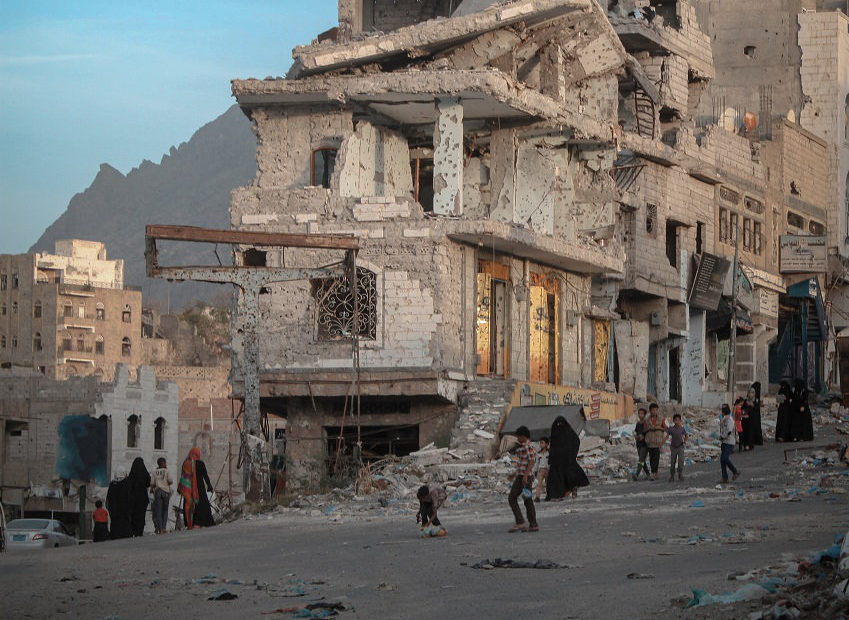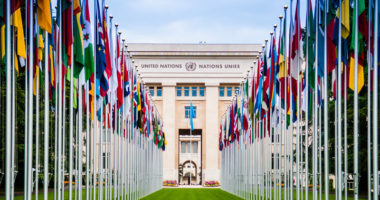The widespread use of heavy explosive weapons has reached alarming levels, exacting a staggering toll on civilian lives. From Gaza to the Democratic Republic of the Congo, Sudan to Syria, and Ukraine to Yemen and Myanmar, the suffering of civilians and destruction is immense, scarring communities long after the bombing stops – but it is also preventable. The Political Declaration on Strengthening the Protection of Civilians from the Humanitarian Consequences Arising from the Use of Explosive Weapons in Populated Areas, endorsed by 86 states worldwide, brings hope of long-term change for civilians caught in conflict. Yet if it is to bring about meaningful impact, it demands resolute action from endorsing states.
In this post, a group of experts from organizations gathering alongside the global community of states to assess progress and challenges and discuss future prospects at the first international follow-up conference hosted by the Norwegian government in Oslo urgently call on states to faithfully implement their commitments and broaden the support for the Political Declaration. They argue that the success of the Declaration hinges on translating political will into meaningful action among endorsing states, including comprehensive policy reforms, enhanced training for military personnel, improved operational planning processes, and robust exchanges of experience and best practices to ensure better protection of civilians and compliance with international humanitarian law (IHL).
War in populated areas is deafening blasts that shatter neighbourhoods, forcing people to flee at a moment’s notice, making hasty decisions over which possessions to bring, despite not knowing whether or how long it will be until they return. It is frantically realizing a child is still at school, trapped amid relentless rockets and artillery in a once peaceful town. It is horror unfolding in the streets, leaving behind lifeless bodies as grim reminders. It is fear and terror gripping communities, leaving homes and livelihoods in ruins, and emptying once-thriving streets.
In today’s landscape of conflict in cities, towns and other populated areas, the use of explosive weapons – including large aircraft bombs, missiles, mortars, rockets, artillery and improvised explosive devices – has become ubiquitous, placing civilians at grave risk of death and injury. In addition to the immediate death and destruction, explosive weapons with a wide impact area unleash a cascade of consequences that destroy critical infrastructure and tear apart the very fabric of a city, reverberating far beyond the munition’s initial point of impact.
Essential services such as water supply, electricity, sanitation and health care are disrupted or collapse, food and water become scarce or unaffordable, and families are forced to flee for survival. Explosive remnants of war litter the streets, posing numerous life-threatening hazards, particularly for children. The physical and psychological scars left by these weapons run deep, fracturing communities and hindering development for decades.
The persisting use of explosive weapons in populated areas is the leading cause of harm to civilians as armed conflicts rage in cities. This underscores the critical importance of the Political Declaration, and demands immediate, concerted and decisive action from states to faithfully and ambitiously implement its commitments to uphold international humanitarian law and alleviate civilian suffering.
An imperative for action
The Political Declaration is a landmark agreement to strengthen the protection of civilians from the increasing use of explosive weapons in populated areas. It is the first instrument of this kind to acknowledge the gravity of the problem and enshrines a critical commitment to curb the use of explosive weapons in populated areas. It sends a powerful signal that all parties to armed conflict must change the way they fight in cities and towns.
The Declaration contains a strong reaffirmation of key IHL obligations and their relevance to the use of explosive weapons in populated areas. It also acknowledges that much more is needed to achieve full and universal compliance with IHL. The Declaration sets important additional guidance, standards, and expectations from endorsing states to protect civilians more effectively. Among others, endorsing states have committed to improving national policies and military practices on the ground and restricting or refraining from using explosive weapons in populated areas as appropriate, all with a view to helping avoid civilian harm.
While international humanitarian law does not expressly prohibit the use of heavy explosive weapons in populated areas, the high likelihood of the indiscriminate effects when using such weapons in urban settings in practice makes it very difficult to abide by the rules of IHL. The Declaration therefore offers a crucial opportunity to fill the gaps left by overly flexible interpretations of international humanitarian law.
Milestone instrument or paper tiger?
As the international community gathers in Oslo this week for a sober assessment of the devastating civilian harm arising from the use of explosive weapons in populated areas and of the impact of the Declaration, the stakes could not be higher. Lives are hanging in the balance, and the time for complacency is up.
While the Political Declaration marks a crucial commitment, concerns have been raised over its implementation by endorsing states. To our knowledge, little to nothing has changed or been implemented by states to overhaul their military practices since the Declaration’s adoption in November 2022, with some maintaining that their existing policies and practices are sufficient. However, more needs to be done to better protect civilians and driving forward change under the Declaration is a continuous process of improvement rather than a tick-box exercise. Seventeen months later, it is evident that mere endorsement and words alone are not enough to stem the tide of escalating violence harming civilians.
The Declaration’s impact may not be immediate, but it has the potential to reshape the future of armed conflicts worldwide. Building stronger standards and driving forward significant change takes time. Endorsing the Declaration is not the end point, but rather the beginning of a longer journey towards tangible change. Comprehensive reform across decades of policies, practices, methods and training will not happen overnight. It will be a long-term undertaking that builds on the international community’s shared goal of reducing civilian harm.
Every state’s commitment to the Declaration, whether that state is involved in urban warfare or not, reflects their commitment to address the challenges civilians face when explosive weapons are used in populated areas, as the ripple effects of explosive weapons use in cities – from large-scale displacement to global energy crises or food insecurity – transcend borders. It falls on the international community – particularly political and military authorities – to work together to broaden support for the Declaration and to effectively implement it.
Embracing international cooperation
As endorsing states navigate the challenges of implementation, it is essential that they uphold the purpose and commitment to strengthening the protection of civilians and the spirit of international cooperation embedded in the Declaration. This entails seeking adherence to its commitments by all parties to armed conflict, including non-state armed groups, holding everyone – including allies – to the same standards, and promoting a principled approach to scrutiny and accountability.
It is up to the global community of officials, the armed forces, and experts from ministries of defence and foreign affairs to rise to the challenge and make real strides towards protecting civilians. The Oslo conference must chart a course for the effective implementation of the Political Declaration by all endorsing states.
This includes initiating a comprehensive review of national policies and practices related to the protection of civilians during armed conflict involving explosive weapons in populated areas. Through this review, states should identify existing gaps in their policies and practices and determine the changes needed for improvement, including notably on how to take into account the indirect effects of explosive weapons’ use on civilians and civilians objects. Endorsing states should report back on the findings of their review and outline measures taken or envisioned to enhance their national policy and practice.
Implementation measures should be tailored to each state’s experiences, capacities, resources, and priorities, with a clear timeline established for execution. Short-term, actionable initial steps, such as translating the Declaration into national languages and integrating it within governmental and armed forces frameworks, should also be encouraged.
Additionally, the implementation of the Declaration should be integrated into the agenda of national IHL committees to facilitate inter-agency coordination and ensure adherence to commitments, including in dialogues with non-state armed groups. Finally, structured exchanges as well as ad hoc meetings and workshops should facilitate ongoing collaboration and knowledge-sharing among stakeholders.
Conclusion
The true impact of the Political Declaration lies in the change it inspires. By heeding the call to action and prioritizing civilian protection, endorsing states can and must uphold the principles of humanity and safeguard people’s lives.
In the face of mounting humanitarian crises and escalating civilian harm, the imperative for action on explosive weapons in populated areas is clear, and so is the choice: stand idly by as communities are torn apart by violence, or take a stand and address it. The time for words has passed; now is the time for robust action.
See also:
- Cordula Droege, Elizabeth Rushing, Israel and the occupied territories: how international humanitarian law applies, December 19, 2023
- Tilman Rodenhäuser, Samit D’Cunha, Foghorns of war: IHL and information operations during armed conflict, October 12, 2023
- Julie Lefolle, Jelena Nikolic, Armed conflict in Sudan: a recap of the basic IHL rules applicable in non-international armed conflicts, June 15, 2023
- Eirini Giorgou, Preventing and eradicating the deadly legacy of explosive remnants of war, February 23, 2023











Comments